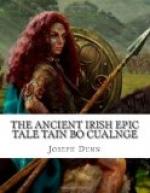The two Cruad, two Calad, two Cir, two Ciar, two Ecell, three Cromm, three Cur, three Combirge, four Feochar, four Furachar, four Casse, four Fota, five Caur, five Cerman, [W.2679.] five Cobtach, six Saxan, six Duach, six Dare, [1]six Dunchadh, six Daimiach,[1] seven Rochad, seven Ronan, seven Rurthech, eight Rochlad, eight Rochtad, eight Rindach, [2]eight Corpre,[2] eight Malach, nine Daigith, nine Dare, nine Damach, ten Fiach, ten Fiacach, ten Fedlimid.
[1-1] Eg. 93 and H. 2. 17.
[2-2] LU. and YBL. 2010.
Ten and six-score[b] kings, [3]leaders and men of the land,[3] Cuchulain laid low in the great slaughter on the Plain of Murthemne, besides a countless horde of dogs and horses and women and boys and children and common folk; for there escaped not a third man of the men of Erin [4]without a wound or a hurt or a blueing or a reddening or a lump or a mark or breaking of thigh or of leg or of shinbone,[4] without having hip-bone broken or half his skull or an eye hurt, or without an enduring mark for the course of his life. [5]And he left them then after inflicting that battle upon them, without having his blood drawn or wound brought on himself or on his charioteer or on either of his horses.[5]
[b] ‘Nineteen and nine-score,’ H. 2. 17 and Eg. 93.
[3-3] Eg. 93 and H. 2. 17.
[4-4] Eg. 93 and H. 2. 17.
[5-5] LU., edition of Strachan and O’Keeffe, page 72, note 19.
* * * * *
[Page 195]
XVIIc
[1]THE ACCOUNT OF THE APPEARANCE OF CUCHULAIN[1]
[W.2706.] [2]Early[2] the next morning Cuchulain came to observe the host and to display his comely, beautiful form to the matrons and dames and girls and maidens and poets and men of art,[a] for he did not consider it an honour nor becoming, the [3]wild,[3] proud shape of magic which had been manifested to them the night before. It was for that then that he came to exhibit his comely, beautiful form on that day.
[1-1] LU. fo. 81a, in the margin.
[2-2] Eg. 93 and H. 2. 17.
[a] A general term for poets, singers, seers and druids.
[3-3] Eg. 93 and H. 2. 17.
Truly fair was the youth that came there to display his form to the hosts, Cuchulain, to wit son of Sualtaim [4]son of Boefoltach (’Of little possessions’) son of Morfoltach (’Of great possessions’) son of Red Neil macRudhraidi.[4] Three heads of hair he wore; brown at the skin, blood-red in the middle, a golden-yellow crown what thatched it. Beautiful was the arrangement of the hair, with three coils of hair wound round the nape of his neck, so that like to a strand of thread of gold was each thread-like, loose-flowing, deep-golden, magnificent, long-tressed, splendid, beauteous-hued hair as it fell down over




